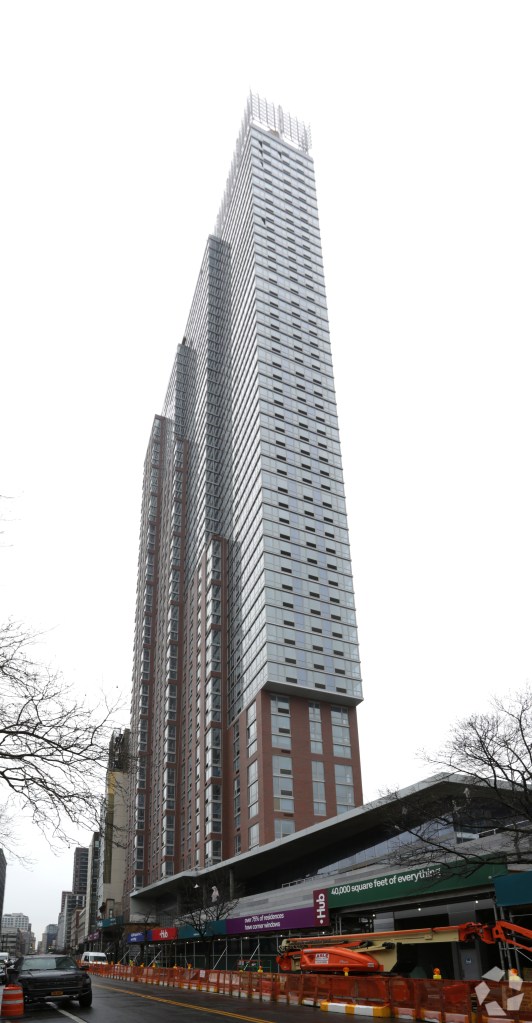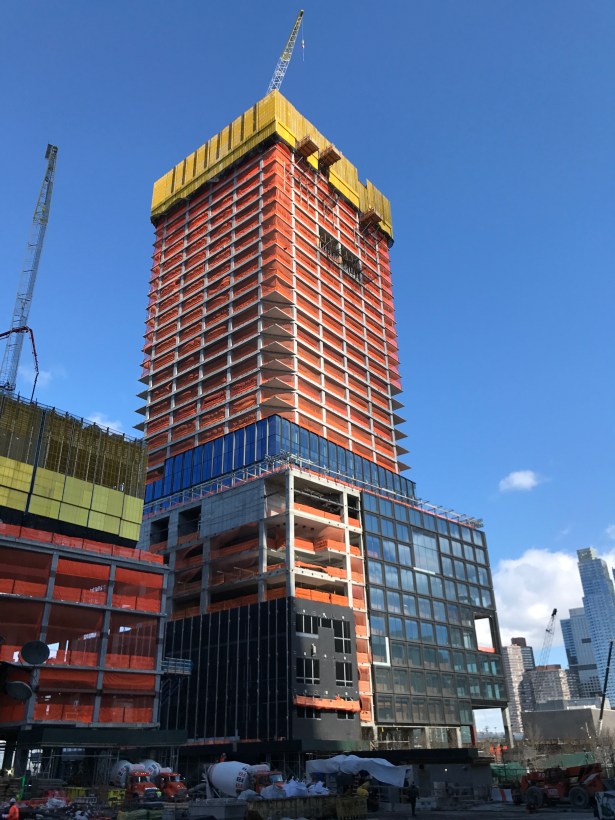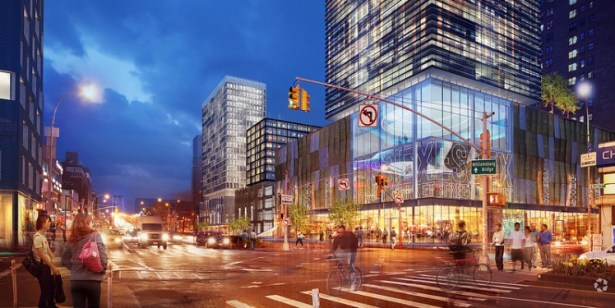Organized Labor Doesn’t Have the Grip They Once Did Thanks to ‘Open Shop’
By Liam La Guerre June 14, 2017 9:45 am
reprints
“New York is becoming an open-shop town.”
That’s what Jay Badame, the president and chief operating officer of AECOM Tishman, said at a panel discussion late last month at the Union League Club in Midtown South hosted by the law firm Zetlin & De Chiara.
It was a blunt assessment from the head of the city’s largest construction management company.
There was a time, Badame said, when he vetted bids for steel and concrete work and excavation from union and nonunion subcontractors at the request of a landlord, and after checking the bids, Tishman went with union subcontractors. The cost, the expertise and the proximity made a union job the logical choice.
That’s no longer the case. At least not on every project.
“The developers are really driving the shift,” Badame continued. “We’re just at their beck and call as it relates to open shop and union. At Tishman we’re very happy—it’s music to our ears—if work is 100 percent union, but in the cases where an owner says, ‘I want you to be open shop,’ we have no choice but to comply with that.”
Many would argue that New York City is already an open-shop town, in which both union and nonunion subcontractors bid for jobs, dangling expertise and cost in front of construction companies. As a result, plenty of projects end up having a mix of union and nonunion workers for different aspects of a job. There are a number of large developments that tell the story.
The consortium of L+M Development Partners, BFC Partners and Taconic Investment Partners is using open shop to construct Essex Crossing, a 1.9-million-square-foot office, residential and retail project in nine buildings. L+M’s subsidiary, L+M Builders Group, and T.G. Nickel are general contractors on the project.

Gilbane Building Company employed the open-shop concept for work on the first phase of Macklowe Properties’ residential conversion of the 944,000-square-foot 1 Wall Street, which was completed in May and included interior demolition and preconstruction services. Douglas Steiner’s 55-story rental skyscraper at 333 Schermerhorn Street in Boerum Hill, Brooklyn—called the Hub—is was completed late last year via open shop construction by New Line Structures.
Thirty years ago, it would be unfathomable for big projects by huge construction companies to be subcontracted to nonunion firms. But, today, landlords and developers are pushing for an even greater expansion of the open-shop concept, and they’ve got their most powerful lobbying arm behind it.
“To the extent that private sector union construction is happening in New York City, it is primarily being done by [Real Estate Board of New York] members,” John Banks, the president of REBNY, said in a statement to Commercial Observer. “Nonunion construction has steadily increased in recent years, however, because union contractors and trade organizations have refused to take steps to become more competitive, while their nonunion counterparts have become much more skilled.”
The biggest reason labor’s grip is slipping comes down to the fact that construction prices have become too high.
New York City has become the most expensive city in the world in which to build, according to the 2017 International Construction Market Survey by Turner & Townsend released in May. The Big Apple has notched $354 per foot in construction costs, unseating Zurich, Switzerland. The report partly blames workers wages for the city’s rise to first place.
“We never sit down and say, ‘Let’s look at nonunion,’ ” Sabrina Kanner, the executive vice president of design and construction at Brookfield (BN) Property Partners, said as a panelist at the Zetlin & De Chiara event. “What I do is put our budget on the table and say, ‘This is the number that I have.’ We wouldn’t be having this discussion today, if in fact construction costs hadn’t gone up 25 percent in the last five years.”
(Brookfield meanwhile has labor agreements with unions for more than 25 million square feet of buildings in the city, Kanner noted.)
While open shop and nonunion are technically separate things—as open shop could result in a project being 100 percent union—the percentage of nonunion workers has risen dramatically in the past few decades along with the number of nonunion companies.
Private construction union members in New York state in 1983 amounted to 48.1 percent or 117,671 of 244,768 total workers, according to unionstats.com, which tracks union membership information. That membership count has dropped to 30.7 percent in 2016 or 122,255 of a total of 398,001 workers.
And lately open shop has become more popular with construction companies, as evidenced by the formation of the first open-shop construction organization in the city last year, the New York Construction Alliance (NYCA), founded by seven construction firms. Together the companies generated revenue of $1.46 billion in 2016 with 813 employees. They worked on 75 projects of just over 16 million square feet last year.
Most experts CO spoke to agreed that open shop has been mostly applied to the residential side of construction. Nonunion workers have dominated construction work on small residential buildings in the outer boroughs for decades as those projects had smaller budgets and union jobs are more costly. And that same reasoning translated to bigger residential sites over time.
“There is a high concentration of open-shop exposure most certainly in the affordable housing sector,” said Kenneth Thomas, the executive director of the NYCA. “There the biggest factor would be the pricing…Most certainly in the housing sector the underwriting is more sensitive given the nature of housing and how narrow the profit margins can be.”
And while data is scarce, there is evidence of a vanishing union presence on projects of more than 100 units, according to a REBNY analysis of New York City Department of Buildings data.
In 2010, there were five residential projects of 100 or more units under construction in the city, and two of them were union; in 2011 there were 13 projects, seven of which were union.
But since then the numbers show a big drop off. In 2015, the most recent year for which numbers are available, there were 146 such projects with just 21, or 14.4 percent, union sites.
Gary LaBarbera, the president of the Building Trades Council of Greater New York, which represents more than 100,000 union workers, contends that small housing projects across the outer boroughs have historically been done nonunion, and as a result unions aren’t actually losing market share.
“[Open shop] is just in the residential marketplace. For decades there has always been a nonunion presence,” LaBarbera told CO. “I’m sure you get calls from REBNY and my friends over there, and I say that sarcastically, because they’re pushing that the unions are losing strength in the area.”
At the same time, LaBarbera pointed out that many open-shop projects have a strong union presence—in some cases “70 percent or 80 percent” union workers, making them essentially union sites.
“It’s undisputable that the massive majority of the tens of billions of dollars that are being performed on construction in general is being done by union construction,” LaBarbera said.
Indeed, outside of residential developments, commercial buildings and public works are almost entirely done by union workers.
According to the New York Building Congress, New York City saw about $43 billion in construction spending in 2016. Approximately $13.4 billion of that was for residential, and the rest was spent on government and commercial projects.
However, the presence of open shops in the commercial sector may be starting to bloom, as well.

Related Companies, Oxford Property Group and Mitsui Fudosan hired Gilbane—a notable proponent of open shop, which it prefers to call “merit” shop—to construct 55 Hudson Yards, a planned 51-story, 761-square-foot office tower. The project has a mixture of union and nonunion workers on site, according to the construction company. (Related and Oxford have a project labor agreement for most of the work at the rail yards.)
Gilbane is also working on Rudin Management and Boston Properties (BXP)’ Dock 72, a 675,000-square-foot office building in partnership with WeWork at the Brooklyn Navy Yard.
And Tishman Speyer hired New Line Structures, a member of NYCA, for its combined 1.2-million-square-foot ground-up office buildings, One and Three Gotham Center, in Long Island City, Queens, that is under construction.
“What [this] is showing you is it’s not just residential, it’s moving into commercial, and soon it will move into the institutional work,” said Billy Gilbane, a senior vice president at the company who runs operations in New York. “It’s best value, and we’re trying to be as inclusive as possible. We believe that for too long New York has operated as a closed market.”
While cracks are appearing in the commercial market generally, getting open shop into public works will be the greatest challenge, and it might explain why the unions have been sanguine about open shop’s sudden visibility.
Public-works jobs require workers be paid prevailing wages by state law. The unions set wages in its collective bargaining agreements with construction companies.
“New York has been, is and will continue to be a robust place for members of the building trades to build our city, region and state,” said Carlo Scissura, the president of the New York Building Congress. “The building trades continue to build New York in a great way.”
According to an Empire Center for Public Policy report in April, the average prevailing wage with benefits for a union construction worker on a nonresidential site is about $75 an hour, an increase of nearly double from the $40 an hour for a site with both union and nonunion labor.
Operating engineers in Gotham bring in an average of $114.5 an hour ($74.20 base salary and $40.30 in benefits), and laborers average $66 per hour ($36.47 in base salary and $30.13 in benefits), according to that report. Meanwhile, carpenters average $96.76 an hour, and electricians bring home $103.44 per hour.
Besides the prevailing wages, most super-large government projects have project labor agreements (PLA), which tend to require a certain percentage of union workers on job sites.
“I think when you look at public works, you look at the large, multibillion dollar projects that the government is building, government will always find a way to give that to the unions,” said Brian Sampson, the president of the Empire State Chapter of the Associated Builders and Contractors, a group that represents approximately 130,000 workers not affiliated with unions in New York City.
“You’ve got the MTA, LaGuardia, Penn Station, bridges, Javits Center, Second Avenue subway, basically any large public project [Gov. Andrew] Cuomo has stipulated they are going to build will be built by PLA. But the governor is a big beneficiary of labor contributions and labor support.”
One point construction experts are making, however, is that taxpayers are paying premiums for these public projects since they aren’t being done open shop. The Empire Center report calculated that the government ends up paying 25 percent more for public projects in New York City because of the high prevailing wages.
“I don’t think there are any serious disagreements that prevailing wages lead to higher cost for taxpayers,” said E.J. McMahon, the research director of the Empire Center for Public Policy who co-wrote the report. “The main union argument is that ‘we’re good.’ ”
McMahon is referring to the unions calling nonunion firms unsafe. To make their case, LaBarbera and others have pointed to the fact that 90 percent of the 35 worker fatalities in the past two years have been on nonunion sites.
McMahon’s report argues that the union’s pension benefits are so high—in many cases nearly 50 percent of workers’ compensation—because the unions have to fight for very expensive pension funds for workers.

“The union model of employee leasing, you can understand it has a lot going for it from an employee standpoint,” McMahon said. “The problem is that they have priced themselves out of competition. And it’s not just greed but that they have to back fill their unpaid liability of pension shortfalls.”
The contest for open shop will be tested later this month when the labor, engineering and metallic lathers unions negotiate collective bargaining agreements with the Contractors’ Association of Greater New York (CAGNY) and Building Contractors Association (BCA), two big construction groups. The deadline to sign a new contract is June 30.
The issues at hand are wages, naturally, but also work rules, which affect those costs. For example, laborers are the only workers that are allowed to clean up and prepare construction sites by removing debris and hazards. If a member of a different trade—say, an iron worker—tried to clean up a site, he will be ordered to stop even if it is quicker and more efficient. Therefore, two people are needed for tasks—one to do ironwork and another to clean and remove items—making projects more costly.
CAGNY, BCA and the unions either declined to speak to CO or could not be reached for comment. However, right now talks haven’t progressed toward a definite agreement, and there is a “50-50” chance a new contract won’t be signed, according to a source with knowledge of the talks that spoke to CO on condition of anonymity.
If the two sides can’t come to an agreement, the construction organizations, both of which are part of the Building Trades Employers’ Association, would be free to use open shop on projects.
“This is a very crucial negotiation,” said Richard Anderson, the president of advisory firm RTA Advisory Services and the former president of the New York Building Congress. “It’s not just about wages: It’s about what they agree to and will they even have a contract.”
He added, “In some ways, [open shop] helps the unions as long as they are flexible and adaptable, because they have quality on their side and they have productivity on their side. What they don’t have is flexibility. And what it’s going to lead to is more and more open shop.”


